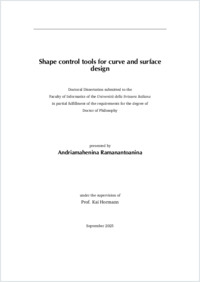Shape control tools for curve and surface design
- Ramanantoanina, Andriamahenina
- Hormann , Kai (Degree supervisor)
- 2025
PhD: Università della Svizzera italiana
Bézier curves
Periodic Bézier curves
Barycentric interpolation
Tangent-interpolating curves
Geometric modeling
Computer-aided geometric design (CAGD)
English
Bézier curves are widely used in geometric modeling, computer-aided design, and computer graphics due to their intuitive control point-based shape manipulation and stable evaluation via the de Casteljau algorithm. Rational Bézier curves extend their capabilities by incorporating weights, which enables the exact representation of conic sections. This thesis investigates advanced shape control mechanisms for rational Bézier curves, including control point-based modifications, weight-based deformations, and interpolation-driven modifications. We show that rational Bézier functions can be written in barycentric form. Essentially, there exists a one-to-one correspondence between these two representations. The barycentric form facilitates additional editing operations, such as shape modification with multiple constraints through interpolation points, interpolation points sliding, and shape-preserving point insertion. We show that these can be achieved by simultaneously updating the parameters of the barycentric form, namely, the interpolation points, the nodes, and the weights. We also show that a single weight manipulation affects the local curvature. Beyond shape control, we analyse the computational efficiency of rational Bézier curve evaluation methods. Although the de Casteljau algorithm offers numerical stability, its quadratic complexity makes it impractical for high-degree curves. We conduct a comprehensive comparison of alternative evaluation techniques, providing insight into their relative performance. We continue the exploration by studying shape control techniques for periodic rational Bézier curves. Similar manipulation techniques transfer analogously from the classical rational Bézier curves. We show that we can also write them in barycentric form, and we explore the editing capabilities enabled by the latter. Due to the apparent deviation from the control polygon in high-degree periodic Bézier representations, we introduce a family of trigonometric tangent interpolating curves. These curves are constructed to closely follow the control polygon by forcing the tangents to be parallel to a control edge at specific parameters. The second variant in this family mimics uniform cubic B-spline behaviour. These trigonometric curves are so far only defined for an odd number of control points, consistent with the dimension of the space of trigonometric polynomials. We explore the construction of closed curves for an even number of points. The final part of this thesis focuses on rational Bézier triangles, which are the natural extension of rational Bézier curves. We also explore the use of Lagrange interpolation. It is crucial to be able to describe geometrically the configuration of nodes so that such interpolating forms exist. Usually, uniformly distributed nodes are used. The Lagrange interpolation also exists if the nodes coincide with the vertices of a triangular grid. We propose a configuration where the nodes lie in nested triangles. We show that this configuration provides enough flexibility for the placement of nodes for low-degree surfaces.
- Collections
- Language
-
- English
- Classification
- Computer science and technology
- License
-
License undefined
- Open access status
- green
- Identifiers
-
- NDP-USI 2025INF014
- ARK ark:/12658/srd1332899
- URN urn:nbn:ch:rero-006-123283
- Persistent URL
- https://n2t.net/ark:/12658/srd1332899
Statistics
Document views: 60
File downloads:
- 2025INF014: 133
